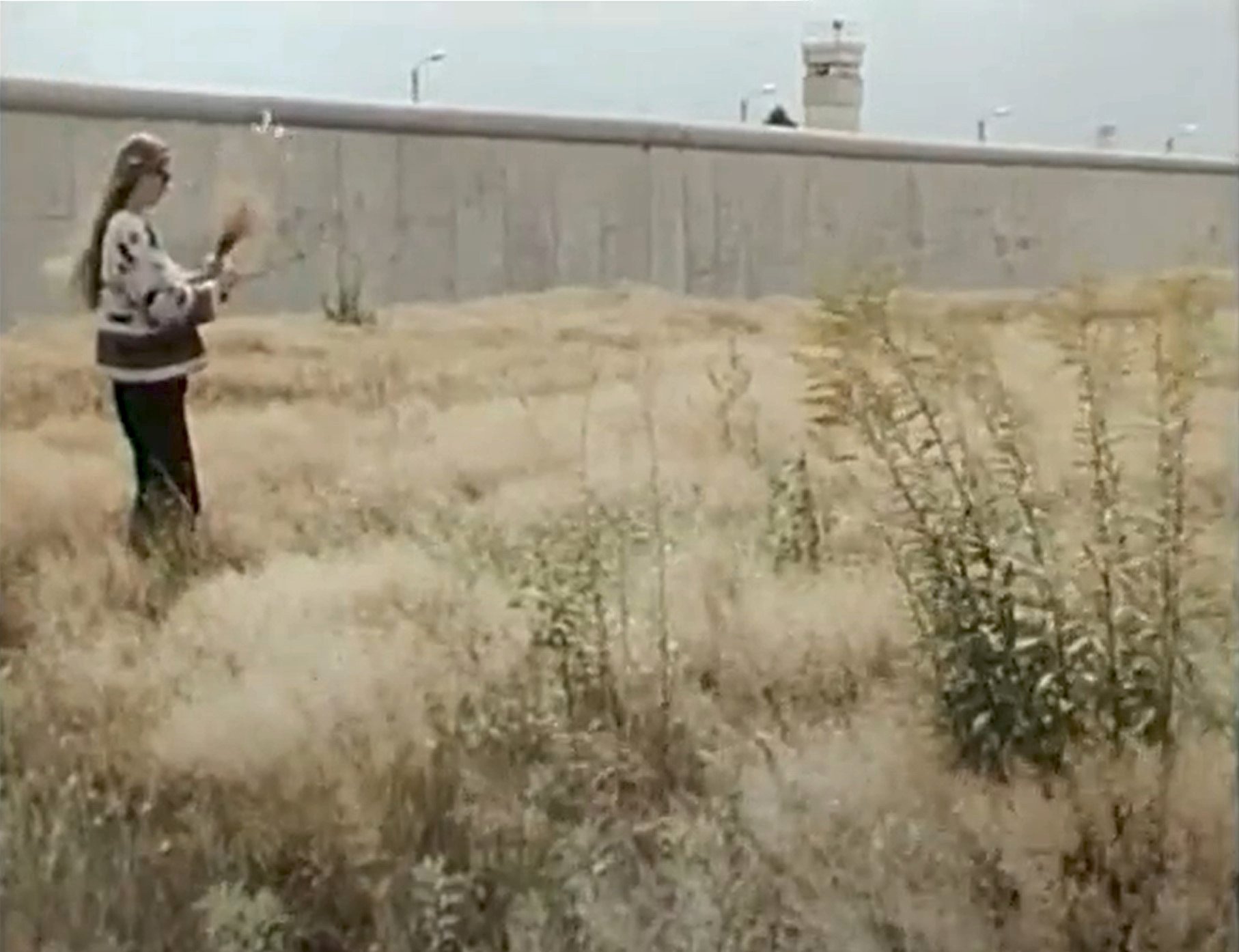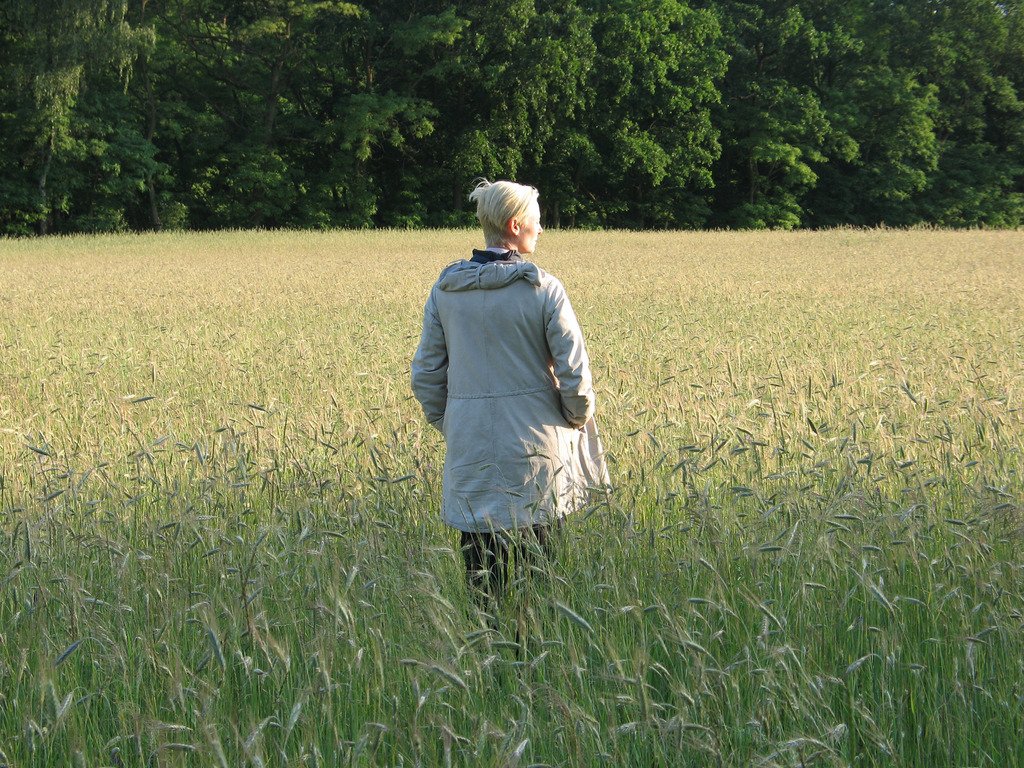Framing the Cycle—Cycling the Frame
Tilda Swinton stands in a lush meadow, sun-dried by the summer of 1989. She picks a few blades of grass and bundles them together. At the horizon, a band of gray concrete prevents the ochre and pale green grass from meeting the faded blue sky. A guard tower looms behind it, alluding to what the Berlin wall prohibits us from seeing. We can only assume the presence of the pair of eyes behind binoculars observing the intimate movie set from the flip side of our viewpoint. If there is anyone at all. In the forcefield of melancholia, joy, and historical estrangement is a vibrating feeling of beauty (Fig. 01).
In Cynthia Beatt’s short film Cycling the Frame (1989), Swinton, as herself, cycles the one hundred miles of West Berlin’s concrete frame. The wall would fall just months after the film’s release. Their twenty-seven minute documentary of ordinary things, poetry, and deep narrative generated such an enthusiastic audience that the team repeated the project twenty years later with The Invisible Frame (2009). In one way, this cinematic pair presents an interpretation relevant to architectural pedagogy. Architects can understand both short films as, first, a suggestion to reconfigure architecture’s learning space—re/cycling the frame—and second, a search for the repetitive rhymes structural to design training—framing the cycles. Both films explore the relationship between changing objects and our ways to access and understand their change.
Architecture is an ever evolving field that is framed and permeated by different divisions from other domains of knowledge production. Like the Berlin Wall, disciplinary borders define their subjects according to the kind of mutual encounter—high wall, hidden wall, transformed wall, invisible wall—sometimes expanding, sometimes closing in. To understand this complexity, we can immerse ourselves, literally and metaphorically, in these twilight zones of perceived insides and outsides. In the early 1970s, Rem Koolhaas spent his diploma Summer Study writing “The Berlin Wall as Architecture.” He recounts his surprise with the Wall’s heartbreaking beauty, “breath-taking in its persistent doubleness . . . different meanings, spectacles, interpretations, realities.”^1
Cycling the frame of any city is an incoherent and yet decelerating method to configure spatial thinking. Swinton’s access to the Wall is reminiscent of Guy Debord’s dérives, the Situationist method of psychogeographical, rapid passages that eventually inspired counter-mapping practices and blurring the borders of “stable continents” in architecture and urbanism.^2 Slowing down to follow a trajectory not designed to be followed can help us explore even the strangest sequence of phenomena in narrative detail. It expands our scope of relevance away from typical spatial configurations: a block, a streetscape, a building, or a place. Further, re/cycling frames means letting our bodies enter the vibratory dance of bodies, social space, and biosphere—away from blank drafting screens and tables. It might remind us that things do not require us to make them interesting, because when you inspect patiently enough, they already are. Dormant visions of shattered dreams are all around us.
^1 Rem Koolhaas, “Field Trip: (A) A Memoir (First and Last…)”, In S, M, L, XL, Rem Koolhaas and Bruce Mau, (New York, The Monacelli Press 1995), 222.
^2 Guy Debord, “Theory of the Dérives,” Internationale Situationniste, Nr. 2, December 1958.
^3 Mark Lee, “Two Deserted Islands,” San Rocco, #1, Winter 2011, 4-10.
^4 Oswald Mathias Ungers, “The City as a Work of Art,” in Architecture Culture. A Documentary Anthology, edited by Joan Ockman and Edward Eigen (New York: Rizzoli, 1993), 364.
Its inverse, framing the cycle, further transcends my argument. With cycles, I refer to the oscillating rhythm between (disciplinary and physical) foreground and background, inside and outside, absence and presence: rhyming cycles to frame for an architecture exceeding techno-aesthetic solutions to building and making. It is an attempt to delineate changing methods of an architectural education still shaped by its twentieth-century inheritance.
Architecture schools seem to uphold their self-referencing syllabi and worn reading lists despite an advantageous position between the humanities and the sciences. Instead of a self-awareness of two sometimes competing but always valuable agendas, Mark Lee’s plea for a “world of fragmentation where definition triumphs over blurring, separation over combination, destination over nomadism” exemplifies this science-led, pedagogical approach. Lee draws on O.M. Ungers’ highly abstracted conception of West Berlin’s “urban islands” in the 1970s. By dismissing anything outside these defined island artefacts as residual space, Lee assembles an argument to foreground city fragments and uncover architectural potential. But this potential bears little reference to the complexity of the already existing “residue” and sanitizes West Berlin to an alienated “Noah’s Ark of the city’s future.”^3 Lee’s dismissal of residual space misreads Ungers’ appreciation of a “spatial totality,” the possibility of movement to extend uninterruptedly in all directions.^4 More problematically, Lee also reinforces Ungers’ controversial strategy to condense the debilitated post-war city into archipelagos to refresh real estate scarcity in a suburbanization trend.
Maintaining the border of architecture means to understand architecture as being fundamentally about making buildings (or something). The more architecture opens up toward other territories, the harder it becomes to explain what architecture is or does. Thus, maintaining the borders of architecture ensures the exclusion of potentially productive residues, emerging from the fear of being unable to define it. But the hidden only appears through the meditation on borders. Cycling as a mode of action understands that architecture sits between maintenance and resistance of these borders. It maintains by following real paths and resists by stretching the limits of time and being.
Cycling the Frame, The Invisible Frame, & Cycles and Frames continue in Issue 31.
Robin V Hueppe is an urban and landscape designer at Dept. and an adjunct professor of architecture at the University of Houston. He practiced internationally in architecture, landscape architecture, and urban design at various firms and published in journals such as OASE, PLAT, City, Culture & Society, and Paprika! Robin holds graduate degrees in architecture and urban design from Rice University and TU Berlin. He has also been a Fulbright fellow at UC Berkeley and studied in Portugal and Brazil.

